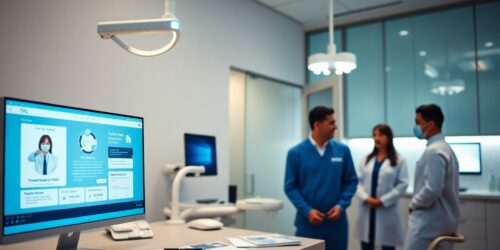How Is Tele-Dentistry Revolutionizing Access To Dental Services For Patients?
You may be surprised to learn how tele-dentistry is changing the landscape of dental care, making it more accessible and convenient for patients like you. This innovative approach allows you to consult dental professionals from the comfort of your home, bridging gaps that traditional office visits often create. As technology continues to evolve, tele-dentistry offers you an efficient way to address your dental needs, receive timely advice, and improve overall oral health without the logistical challenges of traveling to a clinic. Discover how this modern solution is tailoring dental services to fit into your busy lifestyle.
Key Takeaways:
- Increased Accessibility: Tele-dentistry breaks geographical barriers, allowing patients in remote areas to access dental care without traveling long distances.
- Convenience: Patients can schedule virtual consultations from the comfort of their homes, reducing the time and effort involved in traditional dental visits.
- Cost-Effectiveness: By minimizing overhead costs associated with in-office visits, tele-dentistry often results in lower fees for patients, making dental care more affordable.
- Enhanced Education: Virtual platforms allow dentists to provide valuable information and preventative care tips to patients, promoting better oral health practices.
- Efficient Triage: Tele-dentistry helps prioritize dental issues, allowing dentists to assess urgent cases quickly and determine the need for in-person visits when necessary.
Understanding Tele-Dentistry
For many, tele-dentistry offers a transformative approach, bridging the gap between dental care and accessibility. This modern modality enables patients to receive dental consultations, diagnosis, and treatment planning remotely, utilizing technology to enhance convenience and efficiency. With the growing acceptance of virtual healthcare, tele-dentistry is reshaping how you engage with oral health professionals.
Definition and Overview
The term tele-dentistry refers to the use of telecommunications technology to deliver dental care remotely. This practice encompasses video consultations, digital monitoring, and virtual follow-ups, making it easier for you to connect with dental professionals from the comfort of your home. It not only facilitates timely access to care but also supports ongoing management of dental health.
Key Technologies and Tools
To fully utilize tele-dentistry, various technologies and tools are involved in providing effective care. These include video conferencing platforms, dental imaging devices, and mobile applications designed for patient communication and education. Leveraging these tools enhances your interaction with dental professionals and allows for more accurate assessments of your dental needs.
Definition of key technologies in tele-dentistry includes video conferencing apps that enable face-to-face consultations with dentists, allowing for real-time discussions about symptoms or concerns. Additionally, secure patient portals facilitate the sharing of images and medical histories, streamlining the consultation process. Moreover, dental imaging tools capture high-quality visuals of your oral health, which can be transmitted electronically for thorough assessments without requiring physical visits. Together, these technologies empower you to access dental services conveniently while maintaining the quality of care.
Benefits of Tele-Dentistry
The rise of tele-dentistry brings significant benefits to both patients and practitioners alike. By utilizing this innovative approach, you can experience enhanced access to dental care while also addressing specific needs. Through platforms like Breaking Barriers: Teledentistry Expands Access to Care …, patients with various requirements are able to find appropriate dental solutions that were previously out of reach, thus fostering a more inclusive healthcare environment.
Increased Accessibility
An necessary advantage of tele-dentistry is the increased accessibility it offers you. No longer confined to traditional office hours or locations, you can easily consult with a dentist from the comfort of your home, making dental care available to individuals living in remote areas or those with mobility challenges.
Cost-Effectiveness
With tele-dentistry, you can often enjoy reduced costs associated with dental appointments. By eliminating travel expenses and time missed from work, accessing dental care becomes much more manageable for your budget.
Also, many tele-dentistry services provide competitive pricing for virtual consultations, which can be less expensive than in-person visits. Additionally, you may find that early intervention and preventive care through virtual appointments can help mitigate the need for more extensive and costly treatments down the line, ultimately saving you both money and stress.
Challenges and Limitations
Now, as tele-dentistry advances, it does face several challenges and limitations that can impact its effectiveness. Factors such as internet accessibility, technology literacy, and the inability to conduct hands-on examinations can hinder the quality of care you receive. Additionally, the effectiveness of remote consultations can be limited in complex cases that require in-person intervention, making it imperative to consider these issues when utilizing tele-dental services.
Regulatory and Legal Issues
The landscape of tele-dentistry is often complicated by regulatory and legal issues that vary by location. Different states and countries have distinct guidelines regarding licensing, reimbursement, and malpractice liability. It is imperative for you to understand these regulations before engaging in tele-dentistry to ensure that you receive care from a qualified provider while protecting your legal rights.
Patient-Provider Communication Barriers
To navigate tele-dentistry effectively, strong communication between you and your provider is vital. Unfortunately, remote consultations can often lead to miscommunication or misunderstandings due to the lack of in-person interaction, which may hinder your ability to ask questions and express concerns openly.
Plus, time zone differences, technology issues, and varying levels of comfort with digital platforms can further complicate the communication process. Remember that clear communication is key to receiving optimal care, so consider scheduling appointments during your provider’s availability and ensure you have a reliable internet connection for a smoother experience. Being proactive in expressing your needs can also help mitigate these barriers.
Impact on Patient Experience
Once again, tele-dentistry is reshaping how you interact with dental services. By providing virtual consultations, it bridges the gap between you and your dental provider, enabling a more personalized and accessible experience. This innovative approach not only simplifies communication but also enhances your overall satisfaction with your dental care.
Convenience and Comfort
One of the most appealing aspects of tele-dentistry is the convenience it offers. You can schedule appointments from the comfort of your home, eliminating travel time and reducing your exposure to crowded waiting areas. This flexibility allows you to incorporate dental consultations seamlessly into your busy lifestyle.
Quality of Care
About the quality of care, tele-dentistry ensures that you receive professional guidance without compromising on the standards of treatment. Through video consultations, your dentist can assess your concerns and provide effective dental advice, helping you understand your oral health better.
Indeed, when it comes to quality of care, tele-dentistry combines technology with expert knowledge to offer you a comprehensive service. This platform allows for real-time assessments and recommendations tailored to your specific needs. Advanced imaging technologies further enhance these virtual visits, ensuring that your dentist has a complete perspective on your oral health, leading to decisions that prioritize your well-being.
Future Trends in Tele-Dentistry
Keep an eye on the evolving landscape of tele-dentistry as it continues to break barriers in accessing dental care. The integration of advanced technologies and telecommunication tools is poised to enhance patient experiences and treatment outcomes significantly. For more insights, explore Teledentistry: A Comprehensive Review and Its Application ….
Innovations on the Horizon
Along with advancements in technology, you can anticipate innovative tele-dentistry solutions that prioritize patient convenience and comfort. Enhanced diagnostic tools and artificial intelligence will likely enable faster and more accurate assessments, bringing specialized care to your fingertips.
Potential Expansion of Services
Future possibilities include a broader scope of dental services available through tele-dentistry, including preventive care and follow-up treatments. This means you can expect even more comprehensive care options without the need for in-person visits.
Further developments in tele-dentistry will likely lead to the integration of preventive services and orthodontic consultations that can be conducted remotely. This expansion not only makes dental care more accessible but also fosters a proactive approach to oral health, allowing you to manage and prevent dental issues effectively from the comfort of your home.
Case Studies: Successful Tele-Dentistry Models
Not all tele-dentistry models are created equal, but several have proven to be exceptionally effective in enhancing patient access. Here are some successful case studies:
- The patient satisfaction rate rose to 90% in a Texas tele-dentistry program serving underserved populations.
- In California, a tele-dentistry initiative reduced emergency appointments by 30% within the first year.
- A 2021 study found that 85% of patients reported reduced anxiety when using tele-dentistry compared to in-person visits.
- In New York, a program increased routine checkups by 50% following the introduction of virtual consultations.
For further insights, check out Teledentistry: Expanding Access to Oral Healthcare.
Examples from Different Regions
An array of tele-dentistry implementations across various regions reveals its effectiveness. For instance, a model in rural Minnesota demonstrated a significant 40% increase in dental consultations. Meanwhile, urban areas like Chicago reported decreased wait times for appointments, showcasing how these services meet regional needs.
Patient Outcomes and Satisfaction
At the heart of tele-dentistry lies the sentiment of patient satisfaction. Users of tele-dentistry platforms frequently cite improved convenience and access to care, allowing for timely consultations without extensive travel.
Satisfaction levels in tele-dentistry have been overwhelmingly positive, showing that you often experience enhanced overall comfort. Many patients appreciate the ability to consult their dentists from home, reducing barriers like transportation and wait times. As a result, more individuals are engaging in preventive care, which leads to better oral health outcomes and aids in early detection of issues.
To wrap up
As a reminder, tele-dentistry is transforming your access to dental care by offering convenience, efficiency, and broader reach. With virtual consultations and remote monitoring, you can receive timely evaluations and advice from dental professionals without the need for in-person visits. This innovative approach not only saves you time but also helps to cut down on travel expenses and wait times. By embracing tele-dentistry, you can take control of your oral health, ensuring that regular care is more accessible than ever before.
Q: What is tele-dentistry and how does it work?
A: Tele-dentistry refers to the use of digital communication technologies to provide dental care remotely. This can include video consultations, online assessments, and digital imaging. Patients can connect with dental professionals through secure online platforms, allowing them to discuss their oral health, receive preliminary diagnoses, and even participate in follow-up treatment planning from the comfort of their homes.
Q: How does tele-dentistry improve access to dental care for patients in rural areas?
A: Tele-dentistry significantly enhances access for patients in rural or underserved areas where dental services may be limited or difficult to obtain. By eliminating travel barriers, patients can receive professional advice and guidance without the need to visit a physical clinic. This can lead to earlier interventions and more timely care for dental issues, which might otherwise go untreated.
Q: Are there specific types of dental issues that can be addressed through tele-dentistry?
A: Various dental issues can be managed through tele-dentistry, including consultations for toothaches, assessment of dental emergencies, oral hygiene advice, and treatment follow-up. While tele-dentistry cannot replace hands-on treatments like fillings or extractions, it serves as an effective platform for initial evaluations, planning, and maintenance of oral health.
Q: What are the benefits of using tele-dentistry for patients with special needs or mobility issues?
A: Tele-dentistry provides a unique advantage for patients with special needs or mobility challenges by allowing them to access dental care without the stress of traveling. Online appointments can make it easier for these individuals to get the necessary care in a familiar environment, reducing anxiety and making the experience more comfortable. Additionally, it can help caregivers manage appointments more effectively.
Q: How does tele-dentistry contribute to overall public health initiatives?
A: Tele-dentistry plays a vital role in public health by enhancing preventive care and education. It allows for wider outreach during public health campaigns, enabling dentists to provide tips on oral hygiene, dietary advice, and general health education to a larger audience. This proactive approach can lead to improved oral health outcomes and encourage patients to seek regular dental visits, ultimately reducing the burden of dental diseases on the healthcare system.





